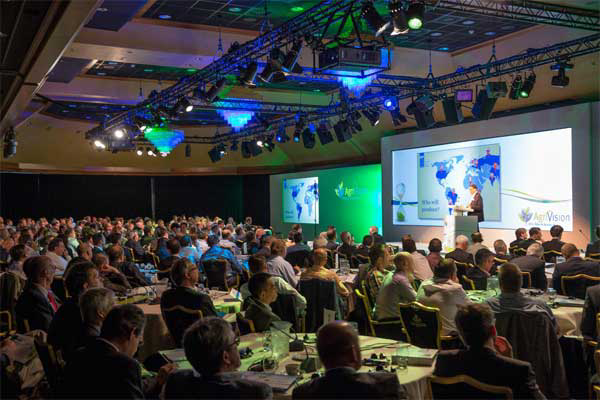Time to resourcify – future food challenges

Leaders of international agri-businesses just ended two days of discussion on how to feed the growing world population from increasingly restricted resources by implementing innovative and collaborative strategies.
They were joined by a broad spectrum of stakeholders gathered at the AgriVision 2013 conference organised by Nutreco. More than 350 delegates from 45 countries took the opportunity to learn, share ideas and be inspired by pre-eminent business managers, entrepreneurs and academics and by the debates that followed. The crucial question of how to provide more from less by revolutionising the management of resources was captured in the conference theme: Time to Resourcify.
Three billion more middle class
One of the key challenges highlighted at the conference was that within the growth of the global population from seven billion today to nine billion in 2050 there will be an extra three billion in the middle classes. These are people with sufficient spending power to choose what they eat and who will increasingly choose high quality animal protein. At the same time, one billion people will struggle to get enough food of any form. Improving the availability of affordable food was another key challenge identified by speakers.
Key factors
Innovation, choice and trade were mentioned as three key factors for a food-secure world. Jerry Vergeer, COO Animal Nutrition Nutreco: “Science and technology cannot solve all the challenges we face but we strongly believe they have a central role to play.” Collaboration across continents and across businesses and regulators was seen to be essential, while strategies for companies to create shared value with the societies in which they operate will be increasingly important for future success. Presenters showed tremendous resource benefits from boosting productivity on large commercial farms, adopting best practices on smallholder farms and reducing food waste. Knut Nesse, CEO Nutreco, in his opening presentation demonstrated that the animal nutrition business already plays an important role in reducing food waste by converting by-products into nutrition. But there remains much to do and science, conducted in a collaborative fashion and translated into local solutions, will help achieve the resource benefits required.
The promise of Africa
Africa, with its unused natural resource wealth and huge potential for productivity increases, held a prominent place in this year’s AgriVision programme. Pioneers shared their knowledge and passion for this continent with the delegates.
Providing science and technology solutions to African farmers is important but not nearly enough to enable the African Green Revolution to really take off.
Commodities exchanges are effective instruments for improving food supply chains in emerging markets. Dr Eleni Gabre-Madhin, Founder and former CEO of the Ethiopia Commodity Exchange emphasised the urgent need for reliable supply chains, both on the input and on the output side. She said, “Agriculture in Africa offers a massive growth opportunity. Yield is currently 25% of the potential on current cultivated land and 67% of arable land is yet to be cultivated.” Referring to this potential, she recommended the participants to “make Africa their next destination.”
“Heineken has a large footprint in Africa, having been active there since 1923. Africa presents more than 20% of Heineken’s business revenues and it is growing,” explained Siep Hiemstra of Heineken. In the absence of functioning markets, Heineken built its own supply chains for local sourcing and in doing so helped farmers move from subsistence to profit. Currently 50% of Heineken’s raw materials are sourced in Africa and Heineken aims to reach 60%.
Strategies for shared value
Keynote speaker, and the world’s foremost authority on strategy, competition and competitive advantage, Professor Michael E. Porter of the Harvard Business School discussed the essence of strategy: namely choosing a unique positioning and a distinctive value chain. He explained how shared value is becoming an integral part of strategy and how this concept offers major opportunities in the animal nutrition industry to innovate and grow while contributing to one of the world’s most important human needs. In that context, the affordability of food and the solutions the agri-business offers is of pivotal importance.
Another pioneer and leader in shared value creation, Vinita Bali, Managing Director of Britannia Industries Ltd., a producer of dairy and baked products, showed how the company identified iron deficiency among 70% of school-going children in India as a consumer need that could be addressed through food. Addressing the problem by fortifying 52% of their products with nutrients resulted in an improved iron status of these children and healthy business for the company.
True leadership
AgriVision 2013 witnessed many more inspiring examples of true leadership. Jerry Vergeer: “Our objective is to bring in high calibre speakers who are leaders, observers and strategists with knowledge of our challenges and ideas to manage them successfully and responsibly. This year’s presenters did an excellent job in encouraging the delegates to take the necessary decisions that will help us produce food that is safe, nutritious and affordable for all consumers.”
AgriVision 2013 was the seventh in the biennial series of multi-stakeholder agri-business conferences organised by Nutreco. The increasing global population and how to feed nine billion people sustainably were central topics throughout the latest AgriVision conferences. At AgriVision 2009, delegates expressed the clear belief that it will be possible to feed nine billion people sustainably by 2050. AgriVision 2011 explored how that can be done and “Sustainable intensification” was identified as one of the key enabling factors. AgriVision 2013 ventured to investigate what this really means in relation to resource production, availability, sourcing and consumption. That is why this year’s AgriVision conference was titled “Time to Resourcify”: Time to provide more food from less of the world’s resources by more efficient and sustainable extraction, conversion and use.













